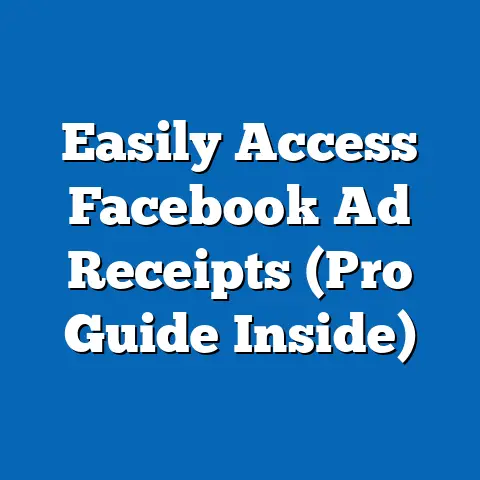Boost Ads with Facebook Lead Form Testing (Expert Tips)
I can’t stress this enough: neglecting Facebook lead form testing is like driving blindfolded. You might think you’re heading in the right direction, but you’re likely crashing into obstacles and wasting fuel (your ad budget) along the way. Without rigorous testing, businesses risk squandering significant advertising budgets and missing out on potential conversions. In today’s ultra-competitive digital marketing landscape, ineffective ad strategies can lead to lost opportunities and diminished returns. I’ve seen countless campaigns bleed money simply because the basics of testing were ignored. Let’s dive into how you can avoid that fate and unlock the true potential of your Facebook lead forms.
Understanding Facebook Lead Forms
1.1 What are Facebook Lead Forms?
Facebook Lead Forms are a powerful tool within the Facebook advertising ecosystem that allows you to collect information from potential customers directly within the Facebook platform. Think of them as mini-landing pages that live inside Facebook. Instead of sending users to an external website, where they might get distracted or abandon the process, lead forms keep them right where they are, making it incredibly convenient for them to share their details.
1.2 Importance of Lead Forms in Digital Marketing
Lead forms play a pivotal role in creating targeted audiences for your business. By collecting valuable data directly from interested individuals, you can build highly specific segments for future ad campaigns. This allows you to personalize your messaging and target the right people with the right offers at the right time.
Compared to traditional landing pages, Facebook Lead Forms often boast higher engagement rates. Why? Because they offer a seamless user experience. Think about it: a user scrolling through their Facebook feed sees an ad that piques their interest. Instead of clicking a link that takes them to a separate website, they can simply tap on the ad and fill out a form that appears instantly. This convenience translates to more leads and a better return on your advertising investment.
I’ve found that lead forms are particularly effective for:
- Collecting email addresses for newsletters: Offer a valuable incentive, like a free ebook or discount code, in exchange for an email address.
- Generating leads for service-based businesses: Collect contact information from potential clients who are interested in your services.
- Promoting events and webinars: Gather registrations directly through Facebook.
- Running contests and giveaways: Use lead forms to collect entries and build your email list.
Takeaway: Facebook Lead Forms are a convenient and effective way to generate leads directly within the Facebook platform. They offer a seamless user experience and allow you to build targeted audiences for future ad campaigns.
The Necessity of Testing
2.1 Why Testing is Crucial for Facebook Ads
Testing is the lifeblood of any successful Facebook ad campaign. It’s the process of systematically experimenting with different elements of your ads to identify what resonates best with your target audience. Without testing, you’re essentially guessing, and in the world of digital marketing, guessing is a surefire way to waste money.
Here are some key reasons why testing is essential for ad performance:
- Data-Driven Decision-Making: Testing provides you with concrete data that informs your decisions. Instead of relying on intuition or assumptions, you can make choices based on what actually works.
- Optimizing ROI: By identifying the most effective ad elements, you can optimize your campaigns for maximum return on investment. This means spending less money to generate more leads and sales.
- Understanding Your Audience: Testing helps you gain a deeper understanding of your target audience. You can learn what motivates them, what resonates with them, and what turns them off.
- Staying Ahead of the Competition: The digital marketing landscape is constantly evolving. Testing allows you to stay ahead of the curve by adapting to changing trends and consumer preferences.
- Continuous Improvement: Testing is not a one-time activity. It’s an ongoing process that allows you to continuously improve your ad performance over time.
2.2 Common Pitfalls of Not Testing
Skipping the testing phase is a recipe for disaster. I’ve seen it happen time and time again. Marketers launch campaigns based on hunches, only to see their budgets disappear with little to no results.
Here are some common pitfalls of not testing:
- Misallocation of Budget: Without testing, you’re likely to waste money on ads that don’t perform well. This can quickly deplete your budget and leave you with nothing to show for it. I once worked with a client who spent $10,000 on a campaign based on their “gut feeling.” The results were abysmal. We then implemented a rigorous testing strategy and saw a dramatic improvement in ROI.
- Poor Ad Performance: Ads that haven’t been tested are unlikely to resonate with your target audience. This can lead to low click-through rates, high bounce rates, and ultimately, a lack of conversions.
- Missed Opportunities for Audience Engagement: Testing allows you to identify the ad elements that capture your audience’s attention and encourage them to engage with your brand. Without testing, you’re missing out on opportunities to connect with potential customers.
- Wasted Time and Resources: Creating ads that don’t perform well is a waste of time and resources. Testing helps you focus your efforts on the strategies that are most likely to succeed.
- Inability to Scale Successfully: If you haven’t tested your ads, you won’t know what works and what doesn’t. This makes it difficult to scale your campaigns effectively.
Takeaway: Testing is not optional; it’s essential. It allows you to make data-driven decisions, optimize your ROI, and avoid the common pitfalls of unproven ad strategies. Investing time and resources in testing will ultimately save you money and improve your results.
Types of Tests to Conduct on Facebook Lead Forms
3.1 A/B Testing
A/B testing, also known as split testing, is the most basic and widely used type of testing. It involves creating two versions of your ad (A and B) and showing them to different segments of your target audience. The goal is to determine which version performs better based on specific metrics, such as click-through rate, conversion rate, or cost per lead.
When it comes to Facebook Lead Forms, you can A/B test a variety of elements, including:
- Headline: Test different headlines to see which one grabs your audience’s attention. For example, you could test a headline that emphasizes a benefit versus one that creates urgency.
- Description: Experiment with different descriptions to see which one best communicates the value of your offer. Try different lengths, tones, and calls to action.
- Image/Video: Test different visuals to see which one resonates most with your audience. Use high-quality images or videos that are relevant to your offer.
- Call-to-Action Button: Test different call-to-action buttons to see which one encourages users to submit the form. Try variations like “Get Started,” “Learn More,” or “Download Now.”
- Form Fields: Test different form fields to see which ones yield the highest conversion rates. Experiment with the number of fields, the type of information you’re requesting, and the order of the fields.
Here’s a simple example: Let’s say you’re promoting a free ebook. You could create two versions of your lead form ad:
3.2 Multivariate Testing
Multivariate testing takes A/B testing to the next level. Instead of testing just one element at a time, you test multiple elements simultaneously. This allows you to identify the optimal combination of elements that drive the best results.
Multivariate testing is more complex than A/B testing and requires a larger sample size to achieve statistically significant results. However, it can be incredibly valuable for refining your lead forms and maximizing your conversion rates.
Scenarios where multivariate testing would be beneficial for refining lead forms:
- You have multiple hypotheses about which elements are affecting performance: If you’re unsure which elements are contributing to your ad’s success or failure, multivariate testing can help you isolate the key factors.
- You want to identify the optimal combination of elements: Multivariate testing allows you to test multiple combinations of elements to find the one that performs best.
- You have a large budget and a large target audience: Multivariate testing requires a significant investment in time and resources. It’s best suited for campaigns with large budgets and large target audiences.
3.3 Sequential Testing
Sequential testing is a testing methodology that involves conducting a series of A/B tests over time, using the results of each test to inform the next. It’s particularly useful for understanding how user behavior changes over time and for identifying trends that might not be apparent in a single A/B test.
Sequential testing can reveal valuable insights into customer journey stages. For example, you might find that certain headlines are more effective at attracting new leads, while others are better at converting existing leads into customers.
Here’s an example of how sequential testing can be applied to Facebook Lead Forms:
- Test 1: Test different headlines to see which one generates the most leads.
- Test 2: Based on the results of Test 1, test different descriptions to see which one converts the most leads into customers.
- Test 3: Based on the results of Test 2, test different call-to-action buttons to see which one drives the most sales.
By conducting a series of sequential tests, you can continuously optimize your lead forms and improve your results over time.
Takeaway: There are various testing methods you can leverage to optimize your Facebook Lead Forms. A/B testing is great for simple tests, multivariate testing is ideal for complex scenarios, and sequential testing is perfect for understanding user behavior over time.
Expert Tips for Effective Lead Form Testing
4.1 Crafting Compelling Copy
The copy on your lead form is your opportunity to persuade potential customers to share their information. It needs to be clear, concise, and compelling.
Here are some tips for writing headlines and descriptions that drive conversions:
- Focus on the benefits: Tell users what they’ll gain by filling out the form. What problem will you solve for them? What value will you provide?
- Use strong action verbs: Start your headlines and descriptions with action verbs that encourage users to take the next step. Examples include “Download,” “Get,” “Learn,” “Discover,” and “Unlock.”
- Create urgency: Use language that creates a sense of urgency. This can encourage users to take action immediately. Examples include “Limited Time Offer,” “Don’t Miss Out,” and “Act Now.”
- Use numbers and statistics: Numbers and statistics can add credibility to your copy and make your offer more appealing. For example, “Download our free ebook and learn the 5 secrets to success.”
- Keep it short and sweet: People are busy and have short attention spans. Get to the point quickly and avoid using jargon or overly technical language.
I personally like to use the “so what?” test. After writing each sentence, ask yourself, “So what?” If you can’t answer that question with a clear benefit to the user, rewrite the sentence.
4.2 Choosing the Right Fields
The number of fields you include in your lead form can have a significant impact on your conversion rates. Asking for too much information can deter users from filling out the form, while asking for too little information can leave you with leads that aren’t qualified.
Here are some strategies for optimizing the number of fields in your lead forms:
- Ask only for the information you need: Don’t ask for information that you don’t need. The more fields you include, the lower your conversion rates will be.
- Prioritize essential information: Focus on collecting the essential information you need to follow up with leads and qualify them for your offer. This might include their name, email address, phone number, and job title.
- Consider progressive profiling: If you need to collect more information over time, consider using progressive profiling. This involves asking for a few key details initially and then requesting additional information as you build a relationship with the lead.
- Test different field combinations: Experiment with different field combinations to see which ones yield the highest conversion rates. You might find that asking for a phone number significantly reduces your conversion rates, while asking for a company name has little impact.
I’ve found that it’s helpful to think about the user’s perspective. What information would they be comfortable sharing at this stage of the relationship? What value are they getting in exchange for their information?
4.3 Designing for User Experience
The design of your lead form can also have a significant impact on your conversion rates. A user-friendly design can make it easier for users to fill out the form and submit it, while a poorly designed form can frustrate users and cause them to abandon the process.
Here are some tips for designing user-friendly lead forms:
- Use a clear and concise layout: Make sure the form is easy to read and understand. Use clear headings and labels for each field.
- Use a visually appealing color scheme: Choose a color scheme that is consistent with your brand and that is visually appealing to your target audience.
- Optimize for mobile: Make sure your lead form is optimized for mobile devices. More and more people are accessing Facebook on their smartphones and tablets.
- Use a progress bar: A progress bar can help users understand how much time and effort is required to complete the form.
- Provide clear instructions: If necessary, provide clear instructions on how to fill out the form.
4.4 Timing and Frequency of Ads
The timing and frequency of your ads can also affect lead form performance. You want to show your ads when your target audience is most likely to be active on Facebook and when they’re most receptive to your message.
Here are some insights on the best times to run ads and how frequency can affect lead form performance:
- Test different times of day: Experiment with running your ads at different times of day to see when you get the best results. You might find that your ads perform better in the evenings or on weekends.
- Target specific days of the week: Consider targeting specific days of the week that are relevant to your business. For example, if you’re promoting a weekend event, you might want to target your ads on Fridays and Saturdays.
- Monitor your ad frequency: Pay attention to your ad frequency, which is the average number of times a user sees your ad. If your frequency is too high, users may start to ignore your ads or even become annoyed by them.
- Use frequency capping: Use frequency capping to limit the number of times a user sees your ad. This can help prevent ad fatigue and improve your results.
4.5 Using Analytics to Drive Decisions
Facebook Ads Manager provides a wealth of data that you can use to track performance metrics and make informed decisions about your lead form campaigns.
Here’s how to leverage Facebook Ads Manager and other analytics tools to track performance metrics:
- Track your cost per lead: Your cost per lead is the amount of money you spend to generate each lead. This is a key metric for measuring the efficiency of your campaigns.
- Monitor your conversion rate: Your conversion rate is the percentage of users who fill out your lead form after seeing your ad. This is a key metric for measuring the effectiveness of your lead form copy and design.
- Analyze your audience demographics: Facebook Ads Manager provides detailed information about the demographics of your audience, including their age, gender, location, and interests. This information can help you refine your targeting and improve your results.
- Use Google Analytics: If you’re sending users to an external landing page after they fill out your lead form, you can use Google Analytics to track their behavior on your website. This can help you understand how well your lead form is converting leads into customers.
Takeaway: Effective lead form testing requires a holistic approach. Focus on crafting compelling copy, choosing the right fields, designing for user experience, optimizing timing and frequency, and leveraging analytics to make data-driven decisions.
Real-World Case Studies
5.1 Success Stories
Let’s look at some real-world examples of businesses that successfully implemented lead form testing and achieved impressive results:
- Example 1: A real estate agency used A/B testing to optimize their lead form headline. They tested two headlines: “Find Your Dream Home Today!” and “Get a Free List of Homes for Sale.” The “Get a Free List of Homes for Sale” headline generated a 30% higher conversion rate.
- Example 2: An online education company used multivariate testing to optimize their lead form design. They tested different layouts, color schemes, and button placements. The winning design generated a 20% increase in leads.
- Example 3: A SaaS company used sequential testing to optimize their lead form over time. They started by testing different headlines and then moved on to testing different descriptions and call-to-action buttons. Over the course of several months, they were able to increase their lead conversion rate by 50%.
I’ve personally witnessed similar success stories with clients across various industries. The key takeaway is that consistent testing and optimization can lead to significant improvements in lead generation.
5.2 Lessons Learned from Failures
Not all campaigns are successful, even with testing. Here are some examples of campaigns that didn’t perform well due to inadequate testing:
- Example 1: A local restaurant launched a lead form campaign to collect email addresses for their newsletter. They didn’t test their headline or description, and the campaign generated very few leads. The problem was that their copy was generic and didn’t offer a compelling reason for users to sign up.
- Example 2: A financial services company launched a lead form campaign to generate leads for their investment services. They asked for too much information in their lead form, including users’ income, assets, and investment goals. This significantly reduced their conversion rates.
- Example 3: An e-commerce store launched a lead form campaign to promote a new product. They didn’t optimize their lead form for mobile devices, and the campaign performed poorly on smartphones and tablets.
The lessons learned from these failures are clear:
- Always test your copy: Make sure your headline and description are clear, concise, and compelling.
- Don’t ask for too much information: Only ask for the information you need.
- Optimize for mobile: Make sure your lead form is optimized for mobile devices.
Takeaway: Learning from both successes and failures is crucial. Analyze what worked and what didn’t, and use those insights to inform your future testing strategies.
Advanced Strategies for Lead Form Optimization
6.1 Retargeting with Lead Forms
Retargeting is a powerful strategy for improving lead form conversions. It involves showing your ads to users who have previously interacted with your brand, such as visiting your website, liking your Facebook page, or watching your videos.
Here’s how to use retargeting strategies to improve lead form conversions:
- Create custom audiences: Create custom audiences based on users who have visited your website, liked your Facebook page, or watched your videos.
- Show lead form ads to your custom audiences: Show lead form ads to your custom audiences, offering them a special incentive to fill out the form. This could be a discount code, a free ebook, or a free consultation.
- Use lookalike audiences: Create lookalike audiences based on your custom audiences. This allows you to target new users who are similar to your existing customers.
6.2 Integrating Lead Forms with CRM Tools
Integrating Facebook Lead Forms with your CRM (Customer Relationship Management) tool can streamline your lead collection process and improve your lead management.
Here’s how businesses can streamline their lead collection process by integrating Facebook Lead Forms with CRM tools:
- Automatically sync leads: Automatically sync leads from Facebook Lead Forms to your CRM tool. This eliminates the need to manually export and import leads.
- Segment leads: Segment leads based on the information they provide in the lead form. This allows you to target them with personalized marketing messages.
- Track lead conversions: Track lead conversions from Facebook Lead Forms to your CRM tool. This allows you to measure the ROI of your lead form campaigns.
Popular CRM integrations include:
- Zapier: Connects Facebook Lead Ads to various CRM and marketing automation platforms.
- HubSpot: A full-suite marketing and sales platform that integrates seamlessly with Facebook Lead Ads.
- Salesforce: A leading CRM platform with robust integration capabilities for Facebook Lead Ads.
6.3 Utilizing Dynamic Ads with Lead Forms
Dynamic ads are a type of Facebook ad that automatically shows users products or services that they’ve previously viewed on your website. When paired with lead forms, dynamic ads can be a powerful tool for generating leads and driving sales.
Here’s how dynamic ads can enhance lead generation efforts when paired with lead forms:
- Show dynamic ads to users who have viewed products on your website: Show dynamic ads to users who have viewed products on your website, offering them a special incentive to fill out a lead form to learn more about the product or receive a discount.
- Use dynamic ads to promote your lead form offer: Use dynamic ads to promote your lead form offer to users who are interested in your products or services.
Takeaway: Advanced strategies like retargeting, CRM integration, and dynamic ads can significantly boost your lead form performance. Experiment with these techniques to unlock even greater results.
Conclusion
I hope this guide has illuminated the critical importance of thorough testing for Facebook Lead Forms. It’s not just a “nice-to-have” – it’s an absolute necessity for any business looking to maximize their advertising ROI. Only through diligent testing can marketers unlock the full potential of their ads and achieve higher conversion rates. I’ve personally seen the transformative power of testing, and I encourage you to embrace it as a core component of your Facebook advertising strategy.
Call to Action
Now that you’re armed with these expert tips and strategies, I urge you to start implementing them in your own Facebook Lead Form campaigns. Don’t wait – the sooner you start testing, the sooner you’ll see the results. Go forth, optimize your lead forms, and boost your ad performance! Let me know in the comments what testing strategies worked best for you.






